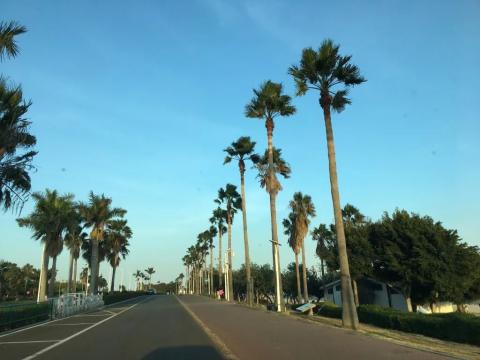
On December 2, 2020, we took a one-day self-driving trip to Xiamen Island. We visited Xiamen Museum, Nanputuo Temple, Huli Mountain Fort, took a sightseeing cable car for sightseeing by the sea, and overlooked Kinmen Island.

1. Itinerary for the day

2. Tour within Xiamen Island
Today we drive by ourselves and take a one-day trip to Xiamen Island. Visited Xiamen Museum, Xiamen University, Nanputuo Temple, and Huli Mountain Fort. Take the sightseeing cable car for sightseeing by the sea and overlook Kinmen Island in the distance. Xiamen is the farthest point on our trip to South China, and it is also the most desirable and beautiful coastal city.
Photos show the beauty.















3. Ocean currents and monsoons carry Chinese ships around the world
Before traveling, I read the preface about Fujian written by Shan Zhiqiang, the 4th issue of "China National Geography" in 2009, and gained a certain understanding of the monsoon and Zheng He's voyages to the West. Try to talk here.
1. Ocean currents and monsoons
Fujian's long and winding coastline and numerous excellent harbors have laid a solid foundation for the Chinese to go to the sea, and the monsoons and ocean currents are precious gifts prepared by nature for the Chinese in the age of sailing ships.
South Asia and Southeast Asia are the most famous monsoon regions in the world, with the northeast monsoon in winter and the southwest monsoon in summer being particularly significant. The surface seawater will flow in a certain direction driven by the wind, forming an ocean current in a specific direction, with a flow speed of up to 0.9 to 2.8 kilometers per hour.
Every winter, northeasterly winds prevail along the southeastern coast of my country. Affected by this, the direction of offshore ocean currents is from north to south. The sea water flows southward from the Yangtze River Estuary to Java Island, and a natural route to the South China Sea is born. When the route extends to the Indian Ocean and continues to expand west and south, navigation is still smooth and smooth due to the influence of the northeast monsoon and monsoon currents in the Indian Ocean.
In summer, the southwest monsoon prevails in the Indian Ocean, and the monsoon currents also change direction. Chinese merchants can then turn their ships and sail back to China. At this time, south of my country's Hangzhou Bay, the coastal currents of the East China Sea and the South China Sea merge with the offshore warm current (mainly the Taiwan Warm Current), flowing from south to north.
The Song and Yuan Dynasties were the most developed periods for overseas trade in ancient my country. At this time, Quanzhou Port in Fujian Province was a world-famous trading port. According to Zhao Rushi's "Zhufan Zhi" of the Southern Song Dynasty, in the first year of Baoqing of the Southern Song Dynasty (1225), there was a connection with Quanzhou. There were 50 countries and regions with trade links; by the ninth year of Zhizheng 9th Year of the Yuan Dynasty (1349), the number had increased to 99 in Wang Dayuan's "Dao Yi Zhi Lue". At that time, there were five main routes between Quanzhou and overseas countries: trade routes with Korea and Japan; trade routes with Indochina and the Malay Peninsula; trade routes with the Philippines and Bani; and trade routes with Sumatra, Java and Kalimantan. Trade routes; trade routes with India, Persia, and Arabia.
2. Zheng He’s fleet took advantage of the monsoon to sail to Southeast Asia
In the age of sailing before the invention of the steam engine, Zheng He's huge fleet had to rely on the help of monsoons and ocean currents to sail smoothly. The area experienced by the Zhenghe route is one of the areas with the most significant monsoon phenomena in the world. Seasonal changes in prevailing winds brought about seasonal changes in ocean currents, providing excellent conditions for Zheng He's navigation. This article is based on Zheng He's nautical charts, combined with knowledge of maritime geography, and analyzes the understanding and utilization of monsoon ocean currents based on Zheng He's voyage dates, routes and speeds during his mission to the West, and uses this aspect to reflect that China was ahead of the world in the 15th century. superb sailing skills.
4. Xiamen, my candidate for retirement vacation
Xiamen is the farthest point on our trip to South China, and it is also the coastal city I most yearn for. As of today, we have traveled for 13 days and covered 2941 kilometers. It passed through the four provinces of Yunnan, Guizhou, Jiangxi, and Guangxi, and experienced climate changes of more than 20 degrees.

When we arrived in Xiamen, it was already the New Year. At the end of December, the temperature in Xiamen is between 15 and 20 degrees Celsius, which feels very comfortable. The taxi driver said that Xiamen has extremely cold winters but not extremely hot summers, so it is comfortable all year round. I thought of the monsoon again. It might be the monsoon that brings warm wind to Xiamen in winter. Climate science is very broad, and I can't give too many specific reasons.
I like Xiamen very much. When driving along the east side of Xiamen Island, I saw such beautiful seaside scenery. I will definitely choose a suitable season to vacation here in the next few years.
